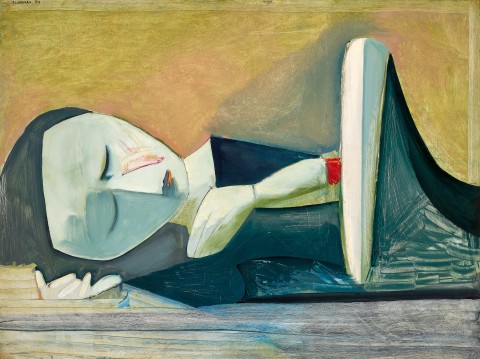SLEEPING FIGURE, 1959
CHARLES BLACKMAN
oil on composition board
90.0 x 120.5 cm
signed and dated upper left: BLACKMAN 59
signed and dated upper right verso: BLACKMAN 1959
Barbara Blackman AO, Canberra
possibly: Blackman, Johnstone Gallery, Brisbane, 26 June – 15 July 1960, cat. 15 or cat. 20
Encapsulating reiterated images of absence and intimacy, withdrawal and embrace, the ‘Suites’ for which Charles Blackman was awarded the prestigious Helena Rubinstein Travelling Scholarship in 1960 are widely considered among the artist’s most impressive achievements, both in scale and conceptual breadth. Influenced no doubt by the groundbreaking ‘Antipodean Manifesto’ penned by Professor Bernard Smith the previous year, here Blackman boldly merged figuration with abstraction in a detailed investigation of psychological portraiture, with the various ensembles juxtaposing individual moments of melancholy, grief or isolation – lonely faces in the street, awkwardly delicate blind women, fragile gestures and spontaneous movements between people. When first unveiled in the artist’s celebrated solo exhibition at The Mathiesen Gallery, London in 1961, such works attracted universal critical acclaim with Eric Newton describing them as ‘…big, tough and tender’ and Francis Bacon admiring ‘the ones with pain’1, while curator Bryan Robertson hailed them as ‘…some of the strongest, most urgent and forceful paintings by a young artist that I have ever seen in the past ten years.’2 As Robertson elaborates: ‘Part of their essential character springs from the interaction, marvellously developed and sustained, between the tenderness and grace of the personages contained in the painting and the fiercely implacably controlled means taken to give these personages life and eloquence within the terms of the painting itself…’3
Imbued with a poignant sense of solitude and featuring the same domination of the canvas by the human figure, Sleeping Figure, 1959 would seem a prelude or catalyst for this important series. Such is persuasively attested moreover, by the inclusion of the pair of shadowy figures verso who, though physically and formally united in a single composition, remain trapped within their respective black frames in a manner prefiguring both stylistically and thematically the ‘secret lovers’ motif of the suites. Incidentally, Sleeping Figure was painted in the sunny Hawthorn studio Blackman rented for a period of six months after exhibiting in the now-legendary Antipodeans Exhibition at the Victorian Artists’ Society in August 1959. With Barbara staying on in Brisbane, the work was possibly inspired by the artist’s serious affair at the time with art student, Christine Birkman, who fell pregnant, and later shared a studio with Emily Hope, daughter of the controversial modernist poet, A.D. Hope. As Felicity St John Moore elucidates, the prose of A.D. Hope was certainly familiar to Blackman and here, allusions to the poem The Massacre of the Innocents, 1955 may be discerned in the pink tear that brushes the face of the odalisque, and the ‘stab’ of red on her left arm which is juxtaposed with a knife-shaped limb.4 There are also unmistakable echoes of Brancusi’s iconic Sleeping Muse, 1910 in the abstracted, mask-like face of the recumbent figure, while the dramatic use of light and psychological intensity characterising both Sleeping Figure and the pair of figures no doubt reveals the artist’s keen interest in the theatre. Indeed, drawing parallels between poetry and the interplay of composite images characterising Blackman’s ‘Suites’, Charles Shapcott’s observations would seem equally apt to describe the relationship between Sleeping Figure and its verso:
‘…there is one larger picture… and the other images fold open around it, illuminating moments of self – the fragile back of a girl’s neck with its revelation of herself more truly perhaps, than her face might permit us; the moment of reaching out to touch another; the moment when alone is a dark quietness or an intense exclusion. The paintings operate with one another and upon one another; it is almost like the juxtapositioning of images in poetry…’5
1. See St John Moore, F., Schoolgirls and Angels, National Gallery of Victoria, Melbourne, 1993, p. 21
2. Bryan Robertson cited in Shapcott, C., The Art of Charles Blackman, Andre Deutsch, London, 1989, p. 36
3. Ibid.
4. Conversation with Felicity St John Moore, June 2021.
5. Shapcott, C., Charles Blackman, University of Queensland Press, Brisbane, 1967, p. 44.
VERONICA ANGELATOS
